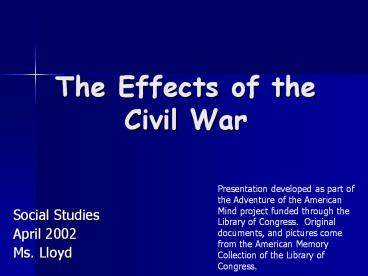The Effects of the Civil War - PowerPoint PPT Presentation
Title:
The Effects of the Civil War
Description:
Civil War. Social Studies. April 2002. Ms. Lloyd ... Abraham Lincoln was the President during the time of the Civil War. ... During the war, everyday life was ... – PowerPoint PPT presentation
Number of Views:1295
Avg rating:3.0/5.0
Title: The Effects of the Civil War
1
The Effects of the Civil War
Presentation developed as part of the Adventure
of the American Mind project funded through the
Library of Congress. Original documents, and
pictures come from the American Memory
Collection of the Library of Congress.
- Social Studies
- April 2002
- Ms. Lloyd
2
The Presidents Role
- Abraham Lincoln was the President during the time
of the Civil War. - He wrote an order that would free all slaves
known as the Emanicipation Proclamation.
3
The Emancipation Proclamation
- Lincoln wrote the Emancipation Proclamation in
1863. - Its purpose was to free the slaves in the
Confederate states. - The president knew that it would make some people
in the North and South angry.
4
Reasons for the Emancipation Proclamation
- The war was going bad for the North.
- Lincoln needed a way to turn things around
- He thought that freeing the slaves in the South
would help bring about that change
5
Effects
- The war, and the Emancipation Proclamation
effected the North and the South.
6
In the North..
- During the war, everyday life was still the same.
- If you had family in the army you worried about
them, but the war was taking place far away from
your home.
Color images from civilwarclipart.com
7
In the South..
- Life was very different because most of the
battles were fought in the South. - Everyday items could not be gotten. Therefore,
you had to make do with the things that you had
and you used items in many different ways.
Color images from civilwarclipart.com
8
After the War in the North
- There were about 360,000 deaths on the Union
(North) side of the war.
- There were more
- factories, which meant
- more jobs.
Flags are from www.civilwarclipart.com
9
After the War in the North
- Many freed
- slaves moved to
- the North.
- The Northern
- states gained a
- lot of power in
- the government.
Flags are from www.civilwarclipart.com
10
After the War in the South
- There were about 260,000 deaths on the side of
the South. - It took along time for the South to recover.
Flags are from www.civilwarclipart.com
11
After the War in the South
- Cities and towns had to be rebuilt.
- People had a hard time believing the
- war was really over.
Flags are from www.civilwarclipart.com
12
The end of Slavery
- As a result of Abraham Lincolns decision.
African slaves now had their freedom. - They were no longer owned like property.
13
The end of Slavery
- Slaves no longer had to live and work on
plantations. - However, some slaves did stay and work for their
former owners. They were still free.
14
What next?
- Most ex-slaves had no education, and had little
or no money. - Some moved North in search for a better life.
- Freed slaves began to form their own
communities. - Although they were free, life was still hard.
15
Hope for the Future
- In 1865 Congress set up the Freedmens Bureau to
help former slaves adapt to the changes in their
lives. - Its greatest contribution was to provide
education for former slaves in the South.










![[PDF] Hospital Trains and Vessels during the Civil War: The Evolution in the Handling and Transportation of the Wounded Paperback – February 19, 2020 Ipad PowerPoint PPT Presentation](https://s3.amazonaws.com/images.powershow.com/10079837.th0.jpg?_=20240717129)




















